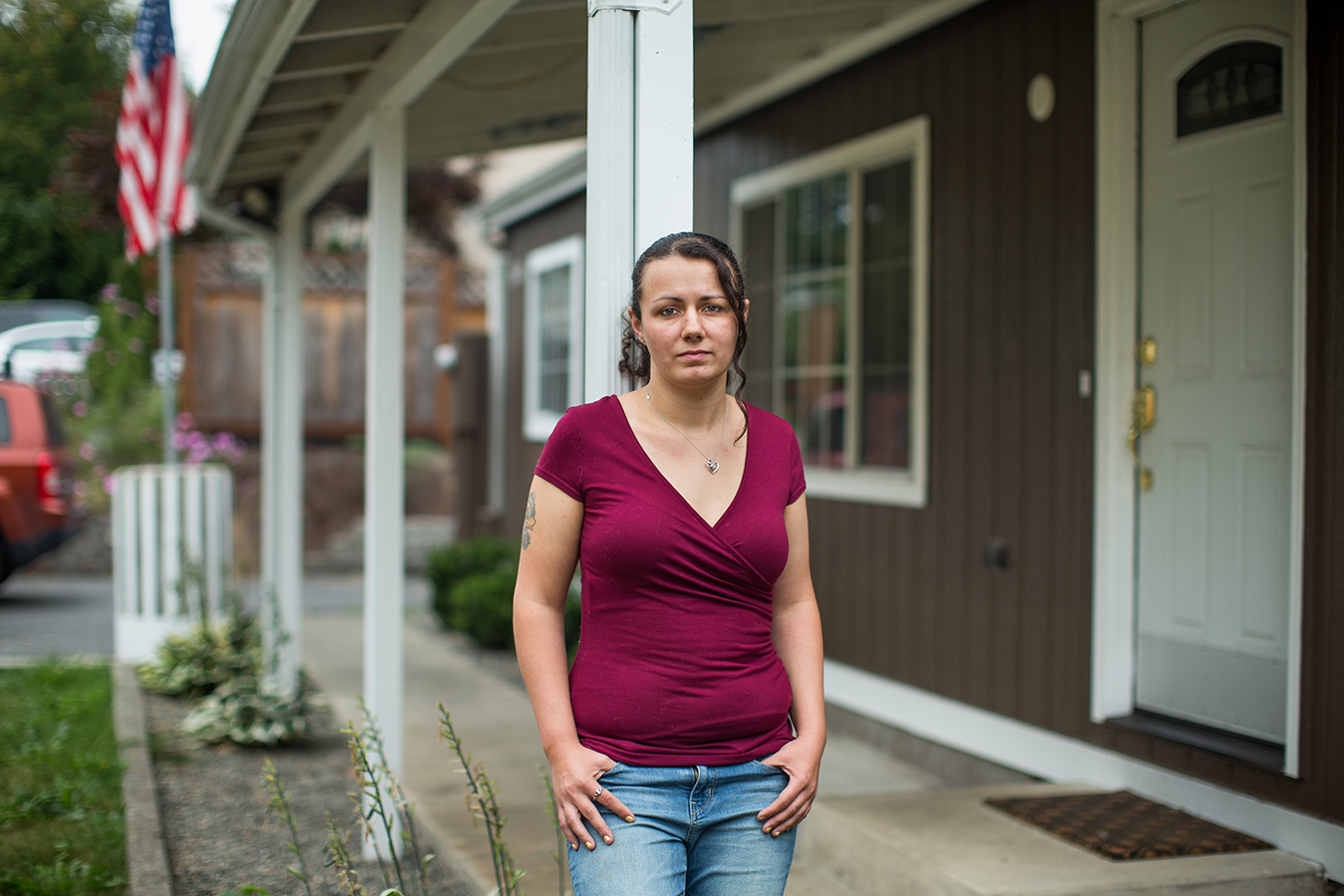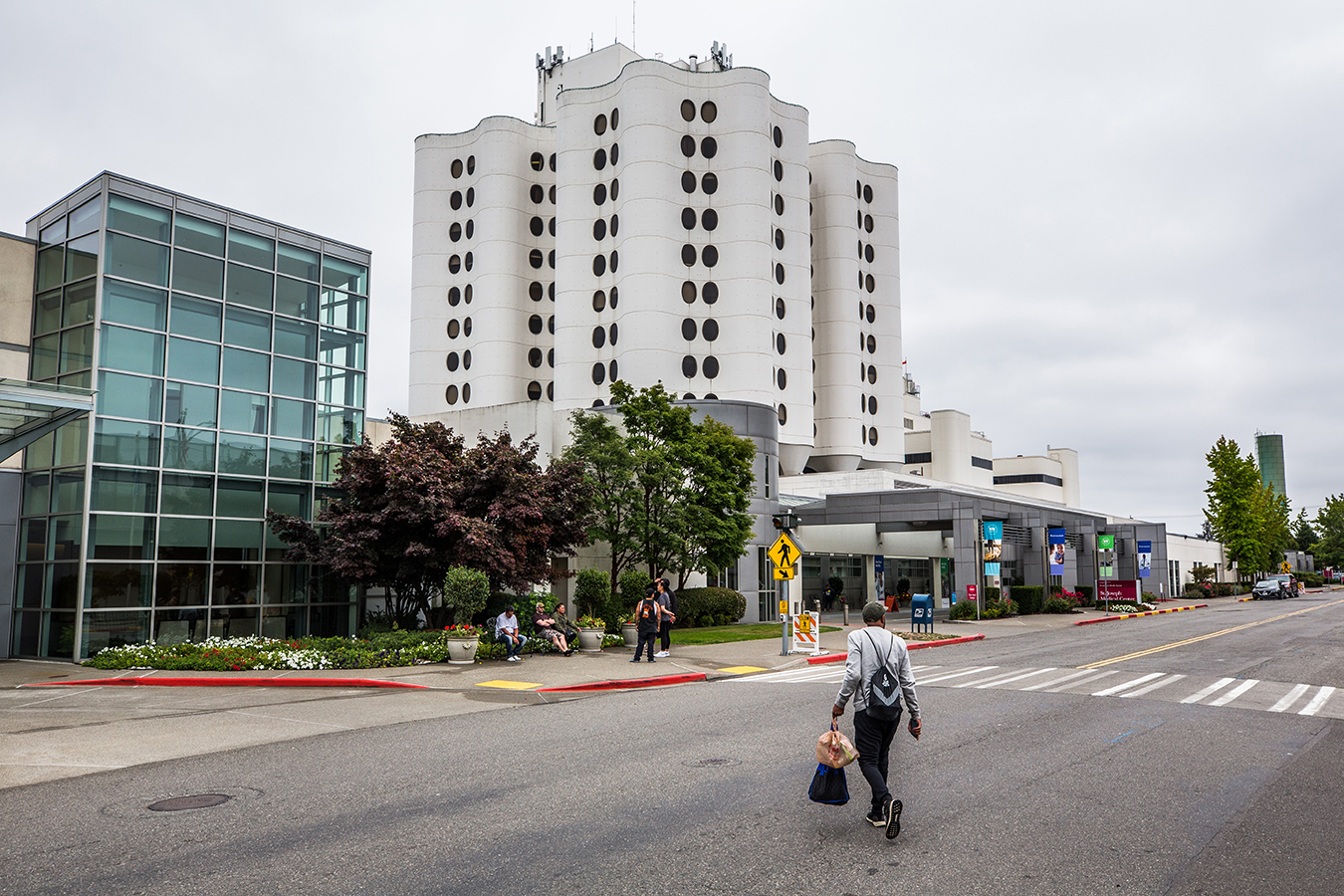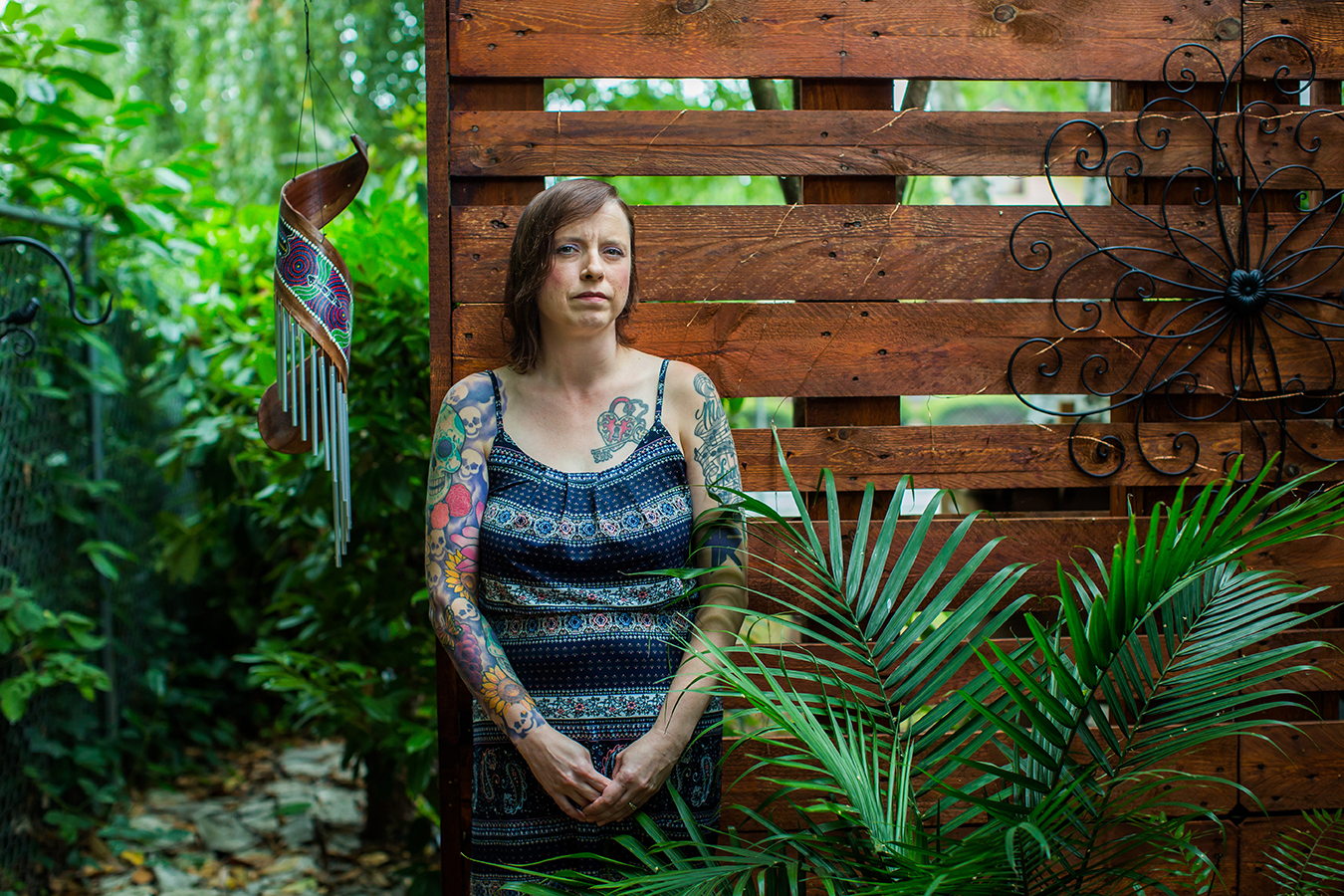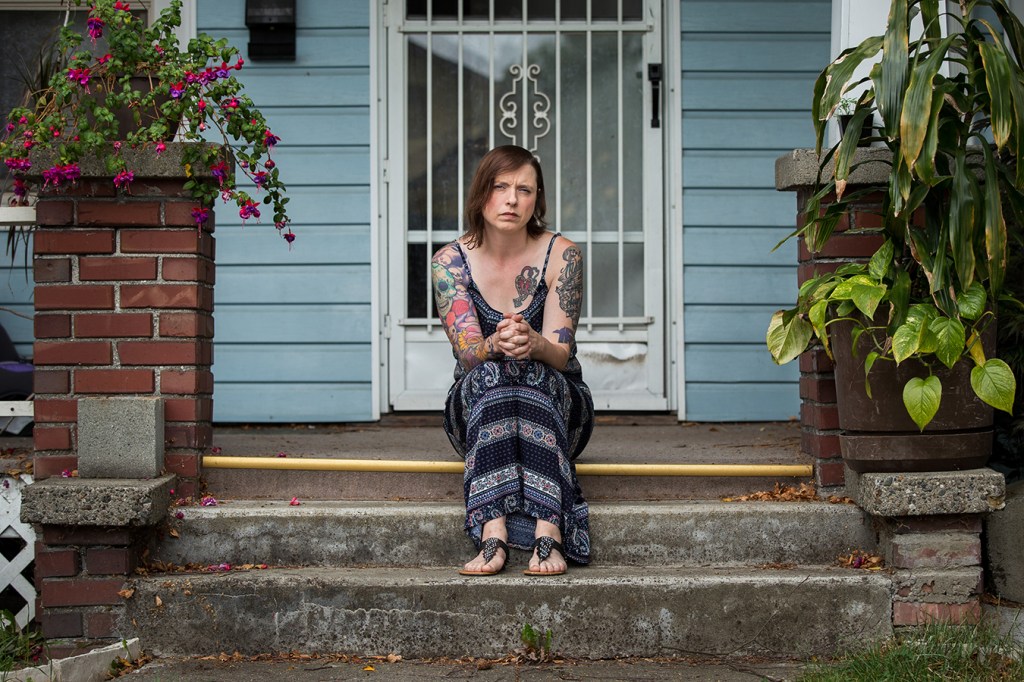When Ashley Pintos went to the emergency room of St. Joseph Medical Center in Tacoma, Wash., in 2016, with a sharp pain in her abdomen and no insurance, a representative demanded a $500 deposit before treating her.
“She said, ‘Do you have $200?’ I said no,” recalled Pintos, who then earned less than $30,000 at a company that made holsters for police. “She said, ‘Do you have $100?’ They were not quiet about me not having money.” But Pintos, a single mom with two kids who is now 29, told state officials St. Joseph never gave her a financial aid application form, even after she asked.
Pintos said she was examined and discharged with instructions to buy an over-the-counter pain medication. Then St. Joseph sent her a bill for $839. When she couldn’t pay, the hospital referred the bill to a collection agency, which she said damaged her credit and resulted in a higher interest rate when she applied for a mortgage.
St. Joseph denied erecting barriers to charity care. But the hospital’s owner settled a lawsuit from the state attorney general earlier this year alleging such practices and agreed to pay more than $22 million in refunds and debt forgiveness.

When Ashley Pintos sought emergency care at St. Joseph Medical Center in Tacoma, Wash., in 2016, an employee first demanded a $500 deposit, which Pintos couldn’t cover. After she was examined, Pintos was told by a doctor to buy an over-the-counter pain medication. The hospital later billed her for $839. “They were not quiet about me not having money,” she says.(Dan DeLong for KHN)
Under the Affordable Care Act, nonprofit hospitals like St. Joseph are required to provide free or discounted care to patients of meager incomes — or risk losing their tax-exempt status. These price breaks can help people avoid financial catastrophe.
And yet nearly half — 45% — of nonprofit hospital organizations are routinely sending medical bills to patients whose incomes are low enough to qualify for charity care, according to a Kaiser Health News analysis of reports the nonprofits submit annually to the Internal Revenue Service. Those 1,134 organizations operate 1,651 hospitals.
Together, they estimated they had given up collecting $2.7 billion in bills sent to patients who probably would have qualified for financial assistance under the hospitals’ own policies if they had filled out the applications.
These written-off bills, known as bad debt, represented a tenth of all nonprofit hospital bad debt reported to the IRS in either 2017 or the most recent year for which data is available. That sum may represent an undercount because it is based on self-reported estimates from hospitals and is not independently audited. And it does not include money that financially struggling patients eventually paid.
“People, including me, had the impression that these new protections under the ACA would prevent people who should be getting help from being financially devastated,” said Sayeh Nikpay, an assistant health policy professor at Vanderbilt University School of Medicine. “Clearly, this policy isn’t working, and that’s a major failing.”
About 56% of American community hospitals have nonprofit status, which frees them of paying most taxes and allows them to float tax-exempt bonds. In return, they are supposed to provide community benefits including free or discounted care for patients who can’t afford to pay.
The IRS leaves it up to each hospital to decide the qualifying criteria. A comparatively generous hospital may give free care to people earning less than twice the federal poverty level — around $25,000 for an individual and $50,000 for a family of four — and may provide discounts for people earning up to double that.
For those who do not qualify, hospitals often offer payment plans. But they can turn to aggressive tactics if bills are not resolved. Patients can be pestered by debt collectors, and some hospitals sue them or try to garnish their wages. Medical debt can damage credit ratings — one study calculated Americans had $81 billion in collections in 2016 — and forces some people into bankruptcy.
When hospitals give up on collecting a bill, they categorize it as bad debt and absorb the cost of the care, which is indirectly subsidized by the rates they charge private insurers.
It became this moneymaking system. People would be crying at registration desks, people would be upset, people would walk out.
Charity Options Often Thwarted
In 2017, BJC HealthCare, a large St. Louis-based system, estimated $77 million of its $134 million in bad debt was owed by patients who probably would have qualified for free or discounted care.
Hospitals now owned by Ballad Health, in Tennessee, estimated that $60 million of bad debt in 2016, or 70%, came from patients who might have been eligible for help.
The Hospital of the University of Pennsylvania said $43 million of its bad debt, or 52%, might have involved patients who could have been excused in 2016 from being billed.
While some hospitals say they write off the debt of poor patients without ever resorting to collection measures, several hospitals whose practices were highlighted in news reports this year for aggressively suing patients admitted to the IRS they knew many unpaid bills might have been averted through their financial assistance policies.
A quarter of bad debt at Mary Washington Healthcare, which sued so many patients that a Virginia court convened special sessions to hear the cases, involved candidates for free or discounted care, according to its IRS filing.
So did half of the bad debt at Methodist Le Bonheur Healthcare in Memphis, called out by news organizations for frequently garnishing wages, its filing said.
CHI Franciscan, which owns St. Joseph, said in multiple IRS filings that none of its bad debt arose from billing indigent patients. While Franciscan admitted no wrongdoing in its settlement with the Washington attorney general, the agreement bars the practice of discouraging charity care in the ways alleged in the lawsuit.

Charity care requests at St. Joseph’s Medical Center in Tacoma, Wash., required so much documentation that half of the requests were rejected, the state attorney general argued in a lawsuit against the hospital. The hospital agreed this year to provide refunds and debt forgiveness to thousands of patients.(Dan DeLong for KHN)
“We are exceeding the requirements of state law and providing charity care compensation to patients who may be in most need, even if they never applied for charity care or did not actually qualify at the time of service,” Cary Evans, a Franciscan spokesman, said in a statement. Franciscan declined to discuss individual patients.
According to the lawsuit and interviews with former employees, St. Joseph’s workers were told never to voluntarily offer patients a charity care application. If asked for one, they were instructed to insist on a deposit at least three times. Even when submitted, applications required so much documentation that half of the requests were rejected, the lawsuit alleged.
Internal hospital training documents the attorney general submitted as part of the case showed that St. Joseph workers were advised on how to best collect money from patients before they left the hospital. Instead of saying, “Can you pay today?” employees were told to use phrases like “How would you like to pay for that today? Cash, check or credit card?” according to the documents.
“It became this moneymaking system,” Rachael Murphy, a former employee, recalled in an interview. “People would be crying at registration desks, people would be upset, people would walk out.”
Pintos, who signed a written statement for the attorney general and was listed as a potential witness in the case, said the hospital never gave her an application even though she had qualified for charity care the previous year. “They made me feel like I wasn’t good enough to be there,” she said.
St. Joseph recently erased the $839 debt from her credit, but Pintos still owes $1,611 for care from the ER doctors, who have their own practice group and do not have to follow the hospital’s charity care policies, according to Franciscan. That bill remains in collections.
‘A Gap In Trust’
Nonprofit hospitals provide roughly $14 billion worth of charity care a year, about 2% of their operating costs. But their policies can have notable exemptions, such as excluding bills from doctors who are not on the hospital payrolls.
However, information about hospital charity care, often included in the reams of admissions documents or posted on hospital walls, can easily get overlooked by patients and families focused on medical emergencies.
“The signage might be a little hard to find, applications are complicated, documentation is complicated,” said Keith Hearle, a consultant who advised the IRS on collecting hospitals’ charity care data. “You could probably come up with 15 reasons people didn’t apply.”
In their IRS filings explaining the bad debt and in interviews, hospitals said that even when they give applications to patients, some fail to submit them or do not provide complete records of their finances, which can include tax returns and bank statements.
“There is a gap in trust where our patients must not believe that if they are willing to share information, that it will be to their benefit,” said June McAllister Fowler, a spokeswoman for BJC HealthCare.
(Story continues below.)
Shana Tate, senior vice president of revenue cycle at Ballad Health, said Ballad is looking to be more proactive.
“We made the assumption that, ‘We give you the information. What more do you need?’ But we realize a lot of patients don’t read it, don’t pay attention,” Tate said. “They need someone to hold their hand through this process.”
Methodist Le Bonheur, which erased more than 6,000 unpaid bills last month, said it is “increasing access to financial assistance information upfront and throughout the patient care journey” and “enhancing the screening process.”
Penn Medicine said that, as a safety-net hospital system, it has many patients who are poor or coping with other problems. These people, Penn said, face “barriers to completing the process for aid” and their bills are typically “left unpaid.”
Mary Washington did not respond to requests for comment, but after critical news reports last June it announced that it was suspending its lawsuits over unpaid bills and reevaluating its practices.
Laurie Jinkins, a state representative from Tacoma and author of legislation to strengthen Washington’s charity care laws, said, “The drive for dollars in the health care system, and the drive for dollars to expand, causes our nonprofit health systems to lose sight of why they’re actually here.” She said St. Joseph had “really gone off the deep end” in its focus on money.
St. Joseph’s practices hark back years, according to the attorney general’s lawsuit and interviews with employees and patients.
After Alisha Colyer’s husband went to the St. Joseph emergency room with pneumonia in 2007, she said, she tried to apply for help, but the charity care application “was like a book you had to fill out.”
“I remember them asking me what make and model my car was, and I was like, ‘You want me to sell my car to pay my hospital bill?’ ” recalled Colyer, who now works at the hospital as a dietary aide.

When Alisha Colyer applied for St. Joseph Medical Center’s charity care around 2007, she remembers them asking what make and model her car was. “And I was like, ‘You want me to sell my car to pay my hospital bill?’”(Dan DeLong for KHN)
In a statement, Franciscan noted that St. Joseph and its other hospitals now use a simplified two-page application designed by the state hospital association and have agreed to make charity care easier to obtain. It also offers free care for medically necessary services to patients earning up to three times the poverty level, which is more than most hospitals do.
It is too early to assess how the policy changes translate into results. The most recent Washington state analysis, for 2017, found St. Joseph lagged behind the regional average in the amount of charity care it provided.
KHN data editor Elizabeth Lucas contributed to this report.
METHODOLOGY
Bad debt figures were derived from the IRS 990 tax returns filed electronically by nonprofit hospital organizations. That information was downloaded in data form from the IRS website on May 7, 2019, by Jacob Fenton, an independent consultant, and analyzed by Kaiser Health News. Returns that included Schedule H, which only hospital-owning nonprofits must file, were analyzed.
For each organization identification number, we selected the return with the most recent tax period end date. In case of duplicates such as amended returns, only the return with the most recent end date and the most recent signature filing date was selected. Because there were still a few duplicates, the one with the largest unique return identifier was selected. The most recent tax returns for 2,508 nonprofits were identified.
Organizations must report their bad debt — bills they have given up on collecting — and, separately, estimate the bad debt “that reasonably is attributable to patients who likely would qualify for financial assistance under the hospital’s financial assistance policy … but for whom insufficient information was obtained to determine their eligibility.” Generally, both figures are greater than the actual cost of providing the services: They are the amount the hospital expected to be paid. For our analysis, we calculated the percentage of bad debt that the organization attributed to patients who might qualify for financial assistance.
A handful of bad debt figures were reported as negative numbers. Those were converted to positives. The amounts were not significant enough to substantially affect aggregates or the analysis’s conclusions.







